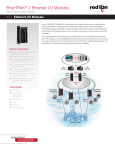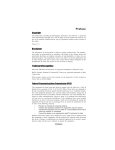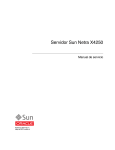Download SV-4103-X4_Operation-Manual
Transcript
4U Single Quad Core Xeon PICMG Server SV-4103-X4 Operations Manual TAG 22355 TAG Way Dulles, VA 20166 Operations Manual 1 Copyright © 2008 Technology Advancement Group®, Inc. (TAG®) All rights reserved. This publication and its contents are proprietary to TAG. No part of this publication may be reproduced in any form or by any means without the written permission of TAG, 22355 TAG Way, Dulles, Virginia 20166-9310. TAG has made every effort to ensure the correctness and completeness of the material in this document. TAG shall not be liable for errors contained herein. The information in this document is subject to change without notice. TAG makes no warranty of any kind with regard to this material, including, but not limited to, the implied warranties of merchantability and fitness for a particular purpose. 1.1 Trademarks All trademarks, marks, names, or product names referenced in this publication are the property of respective owners, and TAG neither endorses nor otherwise sponsors any such products or services referred to herein. SV-4103-X4 Part Number: 1007610 Page 2 of 80 Version 1.1. 09/29/2009 Operations Manual 2 About TAG 2.1 Summary of Qualifications TAG has served as a leading provider of IT solutions to DoD customers over the past 20+ years and has a long-standing and respected history of providing Systems Engineering, Electronic Equipment and Program Management support to US Military warfighters. Headquartered in Dulles, Virginia, TAG’s state-of-the-art 35,000 sq. ft. engineering and manufacturing facility provides all the infrastructure, equipment, and manpower necessary to engineer, design, test, manufacture, and certify products to the rugged requirements of the tactical combat theater. Our facilities in Dulles, VA, San Diego, CA, and St. Louis, MO, allow for rapid deployment of products and support across the globe. TAG quickly, efficiently, and cost-effectively tailors rugged solutions for large DoD programs with specific MIL-STD requirements. TAG’s comprehensive Quality Assurance (QA) policy – enforced through application of our UL-registered ISO 9001:2000 certified processes – enables TAG to rapidly deploy systems and solutions that reliably withstand the stresses of the tactical environment. Today, there are over 20,000 TAG systems deployed across various weapons platforms throughout the US Military. TAG effectively balances all corporate assets – our people, expertise, infrastructure, and experience – to consistently and successfully execute and deliver to the DoD. TAG’s success lies in focusing on the corporate Mission Statement and leveraging the tenets of our business model to ensure the customer’s expectations are exceeded throughout lengthy program lifecycles. TAG’s Mission is to resolve our customers’ IT challenges with World-Class: Engineering; Manufacturing and Integration; and Lifecycle Management TAG has a proven track record in implementing these tenets to serve as a trusted advisor to our Government customers. TAG uses this foundation to ensure risk is mitigated, expectations are exceeded, and the customer can consistently rely on the company, our equipment, and our services. SV-4103-X4 Part Number: 107610 Page 3 of 80 Version 1.1. 09/29/2009 Operations Manual 2.2 Core Competences 2.2.1 Engineering TAG’s engineering methodology is built upon Multi-Disciplinary Optimization (MDO) and rigorous design reviews. Although PMs drive the schedule at TAG, Engineering leverages Computer-Aided Design (CAD) tools, Computational Fluid Dynamics (CFD) modeling, rapid prototyping processes, and diverse test equipment and facilities to ensure requirements are being met at every step of the design. TAG Engineering follows a proven design-review process, ensuring all entrance and exit criteria are met at each stage. Rigorous documentation is compiled to demonstrate requirement compliance, risks are mitigated, and decisions are prudent – throughout the design process. TAG prides itself on its engineering laboratories and facilities. Over the past three years, TAG has invested in several pieces of equipment that allow TAG to test and certify products directly onsite to the harshest environmental requirements of military standards – including the MIL-STD810F and DO 160D. TAG’s onsite test equipment currently includes a Highly Accelerated Lifecycle Testing (HALT) Chamber, an Electromagnetic Interference (EMI) test chamber, and a high-/low-temperature thermal test chamber. TAG’s facility also provides: A floor plan designed to support a cellular manufacturing model with modular assembly lines A dedicated 24-hour system burn-in room A modern production status tracking and Enterprise Resource Planning (ERP) system with external web collaboration capabilities Dedicated Quality Assurance workstations for system compliance and validation inspection 2.2.2 Manufacturing and Integration TAG implements Cellular Manufacturing processes through our compartmentalized, state-of-the-art production facility to minimize waste byproducts and maximize production efficiency. TAG’s manufacturing facility is physically partitioned to model the major philosophies of Lean Manufacturing. Consistent with the model, each of TAG’s production cells are capable of operating in isolation; however personnel and tools are SV-4103-X4 Part Number: 1007610 Page 4 of 80 Version 1.1. 09/29/2009 Operations Manual shared across all cells to streamline manufacturing operations, costs, and the production/integration scheduling. TAG’s floor technicians are cross-trained in multiple disciplines so they can be redistributed to any cell that encounters production bottlenecks, which ensures optimal efficiency. 2.2.3 Lifecycle Management TAG’s world-class Program Management discipline models the renowned methodologies of the Project Management Institute (PMI) to ensure successful completion of the task at hand. Our Program Managers (PMs) serve as the voice of the customer – driving requirements to which the rest of TAG’s organization answers. As an explicit tenet of TAG’s corporate mission statement, the PMs not only track cost, schedule, and technical compliance throughout a project’s period of performance, but also ensure the customer is supported well beyond it. SV-4103-X4 Part Number: 107610 Page 5 of 80 Version 1.1. 09/29/2009 Operations Manual Document Revision History Date 07/09/2008 09/29/2009 Version Number 1.0 1.1 Updated By Alan Huckerby Alan Huckerby Description of Changes Author Author SV-4103-X4 Part Number: 1007610 Page 6 of 80 Version 1.1. 09/29/2009 Operations Manual 3 About This Manual 3.1 Scope and Audience This Manual provides an introductory overview of the SV-4103-X4. Designed to endure the rigors of harsh environments, this device can withstand shock and vibration, high and low temperatures. All of our devices are based on the latest Intel and AMD technology. Also, this device doesn't use Intel Core Due or Pentium M technology (only THS servers). . Configuration options include extended memory and enhanced video optimization. All of our servers are backed by our world-class lifecycle management and post sales support. 3.1.1 Organization: This manual is divided into the following chapters: Chapter 1 Provides Cautions and Warnings. Chapter 2 Provides operational information. Chapter 3 Contains all relevant Procedures. SV-4103-X4 Part Number: 107610 Page 7 of 80 Version 1.1. 09/29/2009 Operations Manual Table of Contents Contents 1 Copyright © 2008 Technology Advancement Group®, Inc. (TAG®) ............................ 2 1.1 Trademarks ............................................................................................................ 2 2 About TAG ................................................................................................................... 3 2.1 Summary of Qualifications ...................................................................................... 3 2.2 Core Competences................................................................................................. 4 2.2.1 Engineering ....................................................................................................... 4 2.2.2 Manufacturing and Integration........................................................................... 4 2.2.3 Lifecycle Management ...................................................................................... 5 3 About This Manual ....................................................................................................... 7 3.1 Scope and Audience .............................................................................................. 7 3.1.1 Organization: ..................................................................................................... 7 4 Safety Instructions ....................................................................................................... 13 4.1 Types of Warnings used in this Manual .................................................................. 13 4.1.1 Safety Symbols and Labels ............................................................................... 13 4.1.2 Conventions ...................................................................................................... 13 5 SV-4103-X4 Overview ................................................................................................. 16 5.1 Product Information ................................................................................................ 16 6 SV-4103-X4 ................................................................................................................. 17 6.1.1 SV-4103-X4‖ Specifications .............................................................................. 17 6.1.2 SV-4103-X4 Components ................................................................................. 20 6.1.3 Trenton 6680 Sys/Host Board ........................................................................... 20 6.1.4 Trenton 6680 Sys/Host Board Components ...................................................... 22 6.1.5 PCI X Bus Frame Grabber ................................................................................ 22 6.1.6 PCI X Bus Frame Grabber Board Components ................................................ 24 6.1.7 MCG-Series PICMG 1.3 PCI System Host Board ............................................. 27 6.1.8 PCI Express System Host Board Components ................................................. 28 6.1.9 PCI Analog Frame Grabber Board .................................................................... 29 6.1.10 PCI Analog Frame Grabber Board Components ............................................. 30 6.1.11 PCI X Digital Frame Grabber .......................................................................... 31 6.1.12 PCI X Digital Frame Grabber Components ..................................................... 33 6.1.13 PCI/Express Graphics Card ............................................................................ 35 6.1.14 PCI Graphics Card Components ..................................................................... 36 6.1.15 Non Rotating Solid State Memory ................................................................... 37 6.2 Power Management ............................................................................................... 39 6.2.1 Power Supply .................................................................................................... 39 6.2.2 Power Supply Components ............................................................................... 39 6.3 COTS 28 Vin Filter ................................................................................................. 41 6.3.1 Vin Filter Features ............................................................................................. 41 7 Procedures .................................................................................................................. 43 SV-4103-X4 Part Number: 1007610 Page 8 of 80 Version 1.1. 09/29/2009 Operations Manual 7.1 SV-4103-X4 Startup ............................................................................................... 43 7.2 SV-4103-X4 Shutdown ........................................................................................... 43 8 Identifying Server Components Using Device Manager ............................................... 44 8.1 Working with Device Properties .............................................................................. 47 8.2 Installing and Removing Hardware in Windows...................................................... 49 8.2.1 Using the Add New Hardware Wizard ............................................................... 50 8.3 Installing Legacy Peripherals .................................................................................. 51 8.3.1 Removing Legacy Peripherals .......................................................................... 51 8.4 TAG Approved BIOS .............................................................................................. 54 8.4.1 BIOS Configuration for Nightvision .................................................................... 54 8.4.2 80 SV-4103-X4 Part Number: 107610 Page 9 of 80 Version 1.1. 09/29/2009 Operations Manual List of Figures Figure 5-1 SV-4103-X4 ................................................................................................. 16 Figure 6-1 SV-4103-X4 ................................................................................................. 17 Figure 6-4 Trenton 6680 Sys/Host Board ...................................................................... 21 Figure 6-5 Trenton 6680 Sys/Host Board (Block Diagram) ........................................... 22 Figure 6-6 PCI X Bus Frame Grabber ........................................................................... 23 Figure 6-7 PCI X Bus Frame Grabber Block Diagram ................................................... 24 Figure 8-1 Control Panel ............................................................................................... 44 Figure 8-2 System Properties ........................................................................................ 45 Figure 8-3 Device Manger ............................................................................................. 45 Figure 8-4 Device Manager ........................................................................................... 47 Figure 8-5 Properties Dialog Box .................................................................................. 48 Figure 8-6 Control Panel ............................................................................................... 50 Figure 8-7 Add Hardware Wizard .................................................................................. 50 Figure 8-8 Control Panel ............................................................................................... 51 Figure 8-9 System Properties ........................................................................................ 52 Figure 8-10 Device Manager ......................................................................................... 52 Figure 8-11 System Overview ....................................................................................... 55 Figure 8-12 CPU Configuration Screen ......................................................................... 55 Figure 8-13 Advanced CPU Settings............................................................................. 56 Figure 8-14 IDE Configuration ....................................................................................... 56 Figure 8-15 IDE Configuration ....................................................................................... 57 Figure 8-16 Floppy Configuration Page......................................................................... 57 Figure 8-17 IDE Configuration Page ............................................................................. 58 Figure 8-18 IDE Configuration Page ............................................................................. 58 Figure 8-19 Floppy Configuration Page......................................................................... 59 Figure 8-20 Floppy Configuration Page......................................................................... 59 Figure 8-21 Super IO Configuration Page ..................................................................... 60 Figure 8-22 Super IO Configuration Page. .................................................................... 60 Figure 8-23 ACPI Configuration Page ........................................................................... 61 Figure 8-24 ACPI Configuration Page ........................................................................... 61 Figure 8-25 South Bridge ACPI Configuration Page ..................................................... 62 Figure 8-26 ACHI Configuration Page ........................................................................... 62 Figure 8-27 ACHI Configuration Page ........................................................................... 63 Figure 8-28 SMBIOS Configuration Page ..................................................................... 63 Figure 8-29 SMBIOS Configuration Page ..................................................................... 64 Figure 8-30 Remote Access Configuration Page .......................................................... 64 Figure 8-31 Remote Access Configuration Page .......................................................... 65 Figure 8-32 Trusted Computing Page ........................................................................... 66 Figure 8-33 Trusted Computing Page ........................................................................... 66 Figure 8-34 MPS Configuration Page............................................................................ 67 Figure 8-35 MPS Configuration Page............................................................................ 67 Figure 8-36 MPS Configuration Page............................................................................ 68 SV-4103-X4 Part Number: 1007610 Page 10 of 80 Version 1.1. 09/29/2009 Operations Manual Figure 8-37 USB Configuration Page ............................................................................ 68 Figure 8-38 USB Configuration Page ............................................................................ 69 Figure 8-39 PCI/PnP Screen ......................................................................................... 69 Figure 8-40 Plug & Play Configuration Popup Screen................................................... 70 Figure 8-41 Onboard VGA Controller Screen ................................................................ 70 Figure 8-42 Onboard VGA Controller Screen ................................................................ 71 Figure 8-43 Onboard VGA Controller Popup Screen .................................................... 71 Figure 8-44 Boot Setting Configuration Screen ............................................................. 72 Figure 8-45 Boot Settings Configuration Popup Screen ................................................ 72 Figure 8-46 Boot Settings Screen ................................................................................. 73 Figure 8-47 Boot Settings Configuration Screen ........................................................... 73 Figure 8-48 Boot Device Priority Screen ....................................................................... 74 Figure 8-49 Boot Device Priority Screen ....................................................................... 74 Figure 8-50 Boot Settings Screen ................................................................................. 75 Figure 8-51 North Bridge Configuration Screen ............................................................ 75 Figure 8-52 Security Screen .......................................................................................... 76 Figure 8-53 South Bridge Chipset Configuration Screen............................................... 76 Figure 8-54 Onboard LAN Boot ROM Screen ............................................................... 77 Figure 8-55 ESB2 PCI X Hub Configuration Screen ..................................................... 77 Figure 8-56 ESB2 PCI X Hub Settings Screen .............................................................. 78 Figure 8-57 Save Changes and Exit Screen ................................................................. 78 Figure 8-58 Save Configuration Screen ........................................................................ 79 SV-4103-X4 Part Number: 107610 Page 11 of 80 Version 1.1. 09/29/2009 Chapter 1 Chapter 1 Cautions and Warnings. Electronically distributed. Subject to user discretion when printed. SV-4103-X4 Part Number: 1007610 Page 12 of 80 Version 1.1. 09/29/2009 Operations Manual 4 Safety Instructions 4.1 Types of Warnings used in this Manual Read this manual thoroughly, paying special attention to the cautions and warnings. 4.1.1 Safety Symbols and Labels DANGER WARNING CAUTION These warnings and cautions indicate situations or practice that might result in property damage. 4.1.2 Conventions 4.1.2.1 Important Messages Important messages appear where mishandling of components is possible or when work orders can be misunderstood. These messages also provide vital information associated with other aspects of system operation. The word ―important‖ is written as ―IMPORTANT,‖ both capitalized and bold and is followed by text in italics. The italicized text is the important message. 4.1.2.2 Warnings Warnings appear where overlooked details may cause damage to the equipment or result in personal injury. Warnings should be taken seriously. Warnings are easy to recognize. The word ―warning‖ is written as ―WARNING,‖ both capitalized and bold and is followed by text in SV-4103-X4 Part Number: 107610 Page 13 of 80 Version 1.1. 09/29/2009 Operations Manual italics. The italicized text is the warning message. 4.1.2.3 Cautions Cautionary messages should also be heeded to help you reduce the chance of losing data or damaging the system. Cautions are easy to recognize. The word ―caution‖ is written as ―CAUTION,‖ both capitalized and bold and is followed by text in italics. The italicized text is the cautionary message. 4.1.2.4 Notes Notes inform the reader of essential but noncritical information. These messages should be read carefully as any directions or instructions contained therein can help you avoid making mistakes. Notes are easy to recognize. The word ―note‖ is written as ―NOTE,‖ SV-4103-X4 Part Number: 1007610 Page 14 of 80 Version 1.1. 09/29/2009 Chapter 2 Chapter 2 SV-4103-X4 . Electronically distributed. Subject to user discretion when printed. SV-4103-X4 Part Number: 107610 Page 15 of 80 Version 1.1. 09/29/2009 Operations Manual 5 SV-4103-X4 Overview Figure 5-1 SV-4103-X4 5.1 Product Information The SV-4103-X4 sets the standard for Servers with state-of-the-art technology. The newest Server can stand up to the harshest environments, and is designed specifically to be fully customized to support unique, missioncritical applications. Your system may contain components not described in this User Manual. For detailed information on these components, refer to the manufactures website or contact TAG Technical Support at [email protected]. SV-4103-X4 Part Number: 1007610 Page 16 of 80 Version 1.1. 09/29/2009 Operations Manual 6 SV-4103-X4 Figure 6-1 SV-4103-X4 6.1.1 SV-4103-X4” Specifications Chassis & Power Supply Dimensions: 7‖H x 16.875‖W x 15‖D. Weight: 30 lbs. Internal Power: The internal "ATX power supply" is provided with two 28Vdc input power supplies. SV-4103-X4 Part Number: 107610 Page 17 of 80 Version 1.1. 09/29/2009 Operations Manual Input DC Voltage: The input power is 28Vdc. System Specifications. Intel Quad Core Low-voltage CPU (L5408, 2.13GHz). Cache: 12MB L2 Cache. Memory: 4GB (2 x 2GB Modules)/Expandable to 8GB. Type: FB-DIMM RAM. System Management: Intelligent fan controller. With Custom Thermal solution to provide operation in extreme temperature environment Environmentally aware Acoustically optimized Storage: (Internal) 2.5‖, SATA, Industrial Flash Drive. PCI Graphics: MSI 8600 GTS PCI-E x16 (NX8600GTS-T2D256E_OC) Graphics Card. PCI Express Analog Video Frame Grabber Card: PC2 COMP EXPRESS PCI-E x1 Analog Video Capture Card. PCI X Analog Frame Grabber Card: X64AN-QUAD PCI-X Analog Frame Grabber Card. PCI X Digital Frame Grabber Card: X64CL DUAL Digital Frame Grabber Card. Operating System: Microsoft Windows XP Professional – 32bit. Imaging Software: Sapera Lite Software. I/O Ports: Three one (1) Gigabit Ethernet Copper (RJ45) connections. (2) are in the Sys/Host Card. (1) In the rear panel. (All are rear panel accessible). SV-4103-X4 Part Number: 1007610 Page 18 of 80 Version 1.1. 09/29/2009 Operations Manual (4) USB 2.0 ports. (Front panel accessible). (1) DB9 COMM Serial Port (rear accessible) PS/2 keyboard and mouse port. (Front panel accessible). Optional Keyboard: Mobile backlit USB keyboard. Pointer: Waterproof optical mouse. Environmental Specifications Operating Temperature: Designed to meet 0°C to 60°C. Non-operating Temperature: Designed to meet -40°C to 70°C. Humidity: Designed to meet 0%-90% noncondensing. Salt/Fog: Designed to meet MIL-STD810F, Method 509.4. Fungus/Mold: Designed to meet MIL-STD810F, Method 508.5. Shock: The server is designed to meet MIL-STD-810F. Vibration: The server is designed to meet MIL-STD-810F. Sand and Dust Protection: The server is designed to meet MIL-STD-8 1 0 F. EMI: The server is designed to meet FCC Class B. Maintenance and Repair The SV-4103-X4 is considered a line replaceable unit (LRU) and will be maintained and spared at the LRU level. SV-4103-X4 Part Number: 107610 Page 19 of 80 Version 1.1. 09/29/2009 Operations Manual 6.1.2 SV-4103-X4 Components This section provides an overview of the most common components installed in the SV-4103X4. Information is also provided on how to identify specific components within your SV4103-X4. For detailed information on the specific components installed, refer the manufactures websites. 6.1.3 Trenton 6680 Sys/Host Board This Backplane/Motherboard su p p o r t s m u lt ip le PCI/Exp r essTM ser ial in t er f aces t o o p t io n car d slo t s an d d evices. Th e f lexib le Syst em Ho st b o ar d Pr o vid es: PCI /Express Graphics Card, PCI Express (Analog Video Frame Grabber Card), PCI X (Analog Frame Grabber Card) including one extra PCI/X slot. PCI X (DUAL Digital Frame Grabber Card). SV-4103-X4 Part Number: 1007610 Page 20 of 80 Version 1.1. 09/29/2009 Operations Manual Figure 6-2 Trenton 6680 Sys/Host Board SV-4103-X4 Part Number: 107610 Page 21 of 80 Version 1.1. 09/29/2009 Operations Manual Figure 6-3 Trenton 6680 Sys/Host Board (Block Diagram) 6.1.4 Trenton 6680 Sys/Host Board Components Pr o cesso r Option (internal pin connector). 4x RS232C serial ports with FIFO. 8x USB 2.0 (4x internal and 4x external). Up to 3x 10/100/1000 Mbps Ethernet Controller, Realtek RTL8111B. Standard PS/2 mouse and keyboard (internal connection available). HD Audio and AC97 compliant. 8 channel GPIO. Temperature, fan and voltages. Software interface to monitor hardware values including HDD S.M.A.R.T. On board Lithium battery and external battery input 0-60°C. Compliance with EN55022 and EN61000-4-2 (ESD). UL609501-1:2003, First edition. CSA C22.2 No. 60950-1-03, First edition, April 1. 2003. RoHS and Lead-free production. Trenton’s PICMG 1.3 compatible backplanes, 170 mm x 170 mm (6.7‖ x 6.7‖). 6.1.5 PCI X Bus Frame Grabber The X64-AN Quad is a high-performance PCIX bus compatible frame grabber. Driven by the need to integrate vision automation with multiple view inspection, the X64-AN Quad is designed to deliver concurrent image acquisition from multiple independent standard and progressive scan analog cameras. SV-4103-X4 Part Number: 1007610 Page 22 of 80 Version 1.1. 09/29/2009 Operations Manual The X64-AN Quad is capable of grabbing from four independent cameras at the same time, and offers independent control signals for each input channel to acquire, transfer and track images accurately. Supporting high-resolution 8-bit image digitization, the X64-AN Quad offers independent image paths creating virtually four frame grabbers in one slot. Figure 6-4 PCI X Bus Frame Grabber SV-4103-X4 Part Number: 107610 Page 23 of 80 Version 1.1. 09/29/2009 Operations Manual Figure 6-5 PCI X Bus Frame Grabber Block Diagram 6.1.6 PCI X Bus Frame Grabber Board Components Image time stamp for accurate object tracking of each input channel. Concurrent acquisition from up to four independent format cameras. High-speed image transfers at up to 528MB/s PCI-X 66MHz compatible. Supports Windows® XP and 2000. Board: Full length 64-bit PCI-X 66MHz compatible Transfers Supports 5V and 3.3V slots SV-4103-X4 Part Number: 1007610 Page 24 of 80 Version 1.1. 09/29/2009 Operations Manual Acquisition: Concurrent image acquisition from four independent interlaced or progressive scan analog cameras. Single slot solution supports acquisition rates up to 50MHz in 8-bit/pixel mode. Horizontal Size (min/max): 32 pixels to 4096 pixels in 1 pixel/step. Vertical Size: 1 to 16384 lines in 1 line/step Interfaces to monochrome standard or custom format cameras Pixel jittter VBS 1 VPP, 75 ohms terminated Pixel jittter Video 0.714 VPP, 75 ohms terminated Pixel jittter Partial scan mode Synchronization: Supports composite video and separate horizontal and vertical sync input. Horizontal/Vertical Drive output, LV TTL and TTL compatible. Frame reset and WEN inputs for each channel. Onboard memory: 128MB Onboard frame buffer memory Pixel Formats: Monochrome 8-bit/pixel. Transfers: Real-time transfers to system memory: PCI-32 bus: 32 bits @ 33MHz. PCI-64 bus: 64 bits @ 66MHz. PCI-X bus: 64 bits @ 66MHz. Pixel jittter: Robust error tracking, reporting and recovery. Look-up tables: One 256 x 8-bit look-up table per channel Noise and Pixel Jitter: +/- 1 LSB with +/- 1.5ns jitter Controls: SV-4103-X4 Part Number: 107610 Page 25 of 80 Version 1.1. 09/29/2009 Operations Manual Independent gain/offset control for each input channel from 0.4V to 1.2V 780µV/step. Anti-aliasing filter: 12MHz1 5th Butterworth. Comprehensive event notification includes end/start-of-field/frame/transfer. 4 independent opto-isolated trigger inputs; programmable as active high or low (edge or level trigger). 4 strobes TTL outputs. PC independent RS232 serial communication ports provide seamless interface to MS Windows applications. Optional: General purpose IO module supports: Inputs and 8 TTL outputs. Inputs support TTL and 24V operations. TTL outputs support PNP and NPN operations. Power Output: Power-on-reset fused +12V DC output at 750 mA(max) for each input channel. Software: Microsoft Windows XP and Windows 2000 compliant. Full support of DALSA’s Sapera programming package. Microsoft Visual Studio 6.0 and .NET. compatible C/C++ DLLs and ActiveX controls. System Requirements: PCI-X compliant system and 64MB system memory. Dimensions: 12.25‖ (31cm) Length x 4.125‖ (10.5cm) Height. Temperature: 0° C (32° F) to 55° C (131° F). Relative Humidity: up to 95% (non-condensing). SV-4103-X4 Part Number: 1007610 Page 26 of 80 Version 1.1. 09/29/2009 Operations Manual 6.1.7 MCG-Series PICMG 1.3 PCI System Host Board The PCI Systems Host board (SHBs) offers a wide variety of board configurations designed to excel in your most demanding and diverse server-class computing applications. Dual-Core processor options provide two and Quad-Core processors provide four execution cores per CPU. For dual-processor board configurations, each CPU has its own independent system bus to reduce data bottlenecks while maximizing processing throughput. The fourchannel memory interface features DDR2-667 FB-DIMMS with a maximum of 16GB. NOTE: This Unit provides a Single Quad core CPU. Figure 6-8 MCG-Series PICMG 1.3 PCI System Host Board SV-4103-X4 Part Number: 107610 Page 27 of 80 Version 1.1. 09/29/2009 Operations Manual Figure 6-9 MCG-Series PICMG 1.3 PCI Express System Host Board 6.1.8 PCI Express System Host Board Components Dual- or Quad-Core Intel® Xeon® Processors and the Intel® 5000P chipset. A single-board design with two processors that provide up to eight processor execution cores per board (1 + 2 = 8 An independent 1066/1333MHz system bus for each processor. Support for 32-bit and 64-bit operating systems. A four-channel system memory interface with standard memory (16GB) and extended memory (32GB) support. Six SATA/300 ports that support RAID 0, 1, 5 and 10 drive arrays. Three Gigabit Ethernet interfaces and eight USB 2.0 ports. Supports PCI Express™, PCI-X and PCI option cards. Compatible with the SHB Express™ (PICMG® 1.3) specification. SV-4103-X4 Part Number: 1007610 Page 28 of 80 Version 1.1. 09/29/2009 Operations Manual 6.1.9 PCI Analog Frame Grabber Board Figure 6-10 PCI Analog Frame Grabber Board Figure 6-11 PCI Analog Frame Grabber Board (Block Diagram). SV-4103-X4 Part Number: 107610 Page 29 of 80 Version 1.1. 09/29/2009 Operations Manual The PC2-COMP ExpressTM is designed to meet the dynamic requirements of generalpurpose video applications. The PC2-COMP Express offers a cost effective solution for a wide variety of application areas including video monitoring, medical visualization, surveillance, and machine vision applications. Its flexible acquisition front-end allows video capture from up to six color or monochrome composite video or two S video cameras. Designed within DALSA’s field proven ―Triggerto-Image Reliability‖ framework, the PC2COMP Express allows OEMs to bring high performance imaging solutions to market faster. 6.1.10 PCI Analog Frame Grabber Board Components Board Half-slot PCI Express 1.0a compliant. Acquisition 6 Composite Video or 2 Y/C (4 CV and 1 YC OR 2 CV and 2 YC). Standard RS170, NTSC, CCIR, and PAL formats. Up to 8MB of frame buffer memory. Image mirroring and vertical flip. Adaptive 2/4 line comb filter for high accuracy chrominance and luminance separation. Arbitrary horizontal and vertical down scaling for randomly sized windows 0.7 VPP 75Ω terminated. Pixel Jitter ± 2ns. Pixel Formats Pixel formats allow 8-bit mono, 16-bit YUV 4:2:2 packed and YUV 4:2:2 planar formats. Transfers Simultaneous live image display and real-time transfers to system memory with no host CPU overhead. DMA supports scatter-gather to optimize host frame buffer usage. Allows on-the-fly camera switching with minimal frame loss. Controls 1 TTL Trigger Input. Detects loss of input video signal. SV-4103-X4 Part Number: 1007610 Page 30 of 80 Version 1.1. 09/29/2009 Operations Manual Comprehensive event notification for start/end of odd/even field or frame signals required for application process synchronization. Software Microsoft Windows XP Professional and Windows XP Professional 64-bit1 compliant. Supports DirectDraw and TWAIN-32. Fully supported of Sapera LT. Application development using C/C++ DLLs and ActiveX controls with Microsoft Visual Studio 6.0 and Microsoft Visual Studio .Net. System Requirement Intel Pentium class CPU, 64MB system memory, 10MB free hard-drive space. Dimensions PCI Express—6.677" (16.95 cm) Length x 4.20". (10.7cm) Height Power Max 1.8A at + 3.3V. Consumption 170mA at + 12V. Temperature. Operating 0°C (32° F) to +50° C (131° F). Storage -40°C (-40°F) to +125°C (257°F). Relative Humidity 5% to 95% (non-condensing). Markings FCC-Approved. CE-Approved. 6.1.11 PCI X Digital Frame Grabber Compatible with one Base, Medium or Full Camera Link camera, the X64-CL Full is universal PCI slot compliant and supports all standard multiple tap area and linescan color and monochrome Camera Link cameras. For greater versatility, the X64-CL Full can also interface with custom camera formats, including pixel depths and tap configurations not covered by the Camera Link standard . SV-4103-X4 Part Number: 107610 Page 31 of 80 Version 1.1. 09/29/2009 Operations Manual Figure 6-12 PCI X Digital Frame Grabber Figure 6-13 PCI X Digital Frame Grabber. Block Diagram SV-4103-X4 Part Number: 1007610 Page 32 of 80 Version 1.1. 09/29/2009 Operations Manual 6.1.12 PCI X Digital Frame Grabber Components Half length PCI 2.1 64-bit 66MHz compliant 5V and 3.3V slot compatible. Acquisition rates up to 680MB/s. Horizontal Size (min/max): 8 byte/256KB. Vertical Size (min/max): Linescan cameras: 1 line to infinity. Area scan cameras: 1 line to 16 million/frame variable length frames. Onboard frame buffer memory up to 2GB (32MB standard). LUT: One 8 or 10-bit(mono/RGB) or 12-bit (mono) input lookup table1. Single slot solution supports 1 Medium, 1 Base or 2 synchronized Base Camera Link cameras. Interfaces to digital area scan or linescan color or monochrome cameras. Supports standard multi-tap Camera Link configurations: 1 Full camera: 8 x 8-bit. 1 Medium camera: 4 x 8-bit, 4 x 10-bit, 4 x 12-bit, 1 x 30-bit/RGB and 1 x 36-bit. 1 Base camera: 3 x 8-bit, 2 x 10-bit, 2 x 12-bit, 1 x 14-bit, 1 x 16-bit, and 1 x 24bit/RGB. Alternate multi-tap Camera Link configurations support: 4 x 14-bit, 4 x 16-bit, 1 x 48-bit or 1 x 64-bit. Pixel Formats •Monochrome 8, 10, 12, 14, 16, or 36-bit/RGB. Transfers •Real-time transfers to system memory: PCI-32 bus: 32 bits @ 33MHz. PCI-64 bus: 64 bits @ 66MHz. PCI-X bus: 64 bits @ 66MHz. On-the-fly tap adjustments for multiple tap area scan and linescan cameras. Controls •Comprehensive event notification includes start/end-of-frame, sequence or N-line events. SV-4103-X4 Part Number: 107610 Page 33 of 80 Version 1.1. 09/29/2009 Operations Manual One independent TTL/LVDS trigger input programmable as active high or low (edge or level trigger). One strobe TTL output for area scan and linescan cameras. One PC independent "serial communication" port provides seamless interface to MS Windows applications. Quadrature (AB) shaft-encoder inputs for external web synchronization; supports cascaded divide and multiply. Power Output •Power-on-reset fused +12V/+5V DC output at 1.5A. Software •Microsoft Windows NT 4.0, Windows 2000, and Windows XP compliant. Full support of the Sapera programming package. Compatible with Microsoft Visual Studio 6.0 and .Net (unmanaged code only). Visual Basic 6.0 and Borland C++ Builder 5.5 or higher. System Requirements •PCI-64 or PCI-32 compliant system and 64MB system memory. Dimensions •8.27‖ (21cm) Length x 4.20‖ (10.7cm) Height. Temperature •0° C (32° F) to 55° C (131° F) Relative Humidity: up to 95% (noncondensing). SV-4103-X4 Part Number: 1007610 Page 34 of 80 Version 1.1. 09/29/2009 Operations Manual 6.1.13 PCI/Express Graphics Card MSI's NX8600GT Twin Turbo videocard has push-button shader overclocking! By default the videocard comes pre-overclocked with its core running at 600 MHz and memory at 1600 MHz (stock is 540/1400). MSI's NX8600GTS-T2D256E-OC videocard is based on the new nVIDIA GeForce 8600GTS core. The card packs in a modest 256MB of GDDR3 memory. This PCI Graphics card enhances image quality: Brings the easiest way to optimize graphic quality. Colorize your vision when browsing digital photographs. Sharpens characters edges. Figure 6-14 PCI/Express Graphics Card SV-4103-X4 Part Number: 107610 Page 35 of 80 Version 1.1. 09/29/2009 Operations Manual Figure 6-15 PCI/Express Graphics Card (Connectors) 6.1.14 PCI Graphics Card Components Support Memory NX8600GTS-T2D256E-OC videocard 700 MHz core, 2100 MHz memory. 256MB DDR3 Video Output Function Dual-link DVI Support HDTV/HDCP Support TV-out + Dual DVI Connectors GPU: 675MHz. Memory: 2000MHz Performances Graphics Bus Technology: PCI Express. Memory: 256MB. Memory Interface: 128-bit. Memory Bandwidth (GB/sec): 32. Fill Rate (Billion pixels/sec): 10.8. RAMDACs (MHz): 400. Custom Cooling Solution SV-4103-X4 Part Number: 1007610 Page 36 of 80 Version 1.1. 09/29/2009 Operations Manual 6.1.15 Non Rotating Solid State Memory Figure 6-16 2.5‖, SATA, Industrial Flash Drive 6.1.15.1 2.5”, SATA, Industrial Flash Drive SMART Modular Technologies’ XceedLite SATA SSD product line offers the industry's lowest power consumption for rugged, low cost data storage applications. Ideally suited for HDD replacement in systems that require high reliability storage in a low profile (H-5mm x W68.9 x L-100.25) package, the industrial grade XceedLite is suited for use as rugged, reliable boot drives in a wide range of communications applications including mobile and embedded computing, medical, automotive, and industrial. The XceedLite features enhanced reliability as a result of advanced on-board error detection as well as correction and comprehensive wear leveling algorithms that provide consistent operation throughout the product life cycle. Compatibility Serial ATA: High-speed serialized AT attachment, revision 1.0a, Serial ATA working group. SV-4103-X4 Part Number: 107610 Page 37 of 80 Version 1.1. 09/29/2009 Operations Manual Performance Burst Read/Write: 150MB/sec. Sustained Read: up to 40MB/sec. Sustained Write: up to 25MB/sec. Access time:.2ms (typical). Physical Form factor: 2.5‖. Dimensions (mm): 100.25 (L) x 68.9 (W) x 5 (H). Weight: 0.1kg (16GB). Environmental Operating temperature. Industrial grade: 0ºC to +70ºC. Industrial temp: -40ºC to +85ºC. Storage temperature: -65ºC to +150ºC. Humidity: 5% to 95%. Operating altitude: up to 80,000 ft. Operating shock: 50G peak @ 2ms. Operating vibration: 15G peak to peak. Power Input voltage: 5.0V ± 5%. Typical consumption. Idle: 60mA. Sustained Read/Write: 110mA/130Ma. Compliance CE, UL, EN 55022 Class B, CISPR 22 Class B, AS/NZS 3548 Class B, BSMI CNS 13438 Class B, CAN/CSA-V-3/2001.04 (VCCI), FCC Part 15 Class B, EN 61000-3-2, EN 61000-3-3, IEC 61000-4-2/3/4/5/6/8/11. Reliability MTBF:>2 million operating hours. EDC/ECC: 32-bit Reed-Solomon. Bit Error Rate (BER)<10-14. Built-in power-up self-test (BIT). Manual and automatic self-diagnostics. Data integrity under power-cycling. Endurance Read unlimited 2,000,000 write/erase cycles SV-4103-X4 Part Number: 1007610 Page 38 of 80 Version 1.1. 09/29/2009 Operations Manual 6.2 Dynamic wear-leveling 10 years data retention Power Management Modern motherboards provide Advanced Configuration and Power Management Interface (ACPI) settings such as wake-up, power button function and standby/suspend timers. These functions are configured in the CMOS Setup. (Section 8-4 BIOS Setup). 6.2.1 Power Supply Two 300W DC power supply modules are supplied. One 300W DC module will supply power solely to the .backplane ATX connector. The second 300W DC module will supply all other power requirements. Including power supply to auxiliaries such as: Fans, HD, etc. Figure 6-17 Zippy Power Supply 6.2.2 Power Supply Components Output Wattage 300W. Dimension 225.00x100.00x40.50mm. 8,85x3.94x1.59‖ inch. DC Input Spec Voltage: DC20V~28V SV-4103-X4 Part Number: 107610 Page 39 of 80 Version 1.1. 09/29/2009 Operations Manual Input Current: 20.0A (RMS) for 24VDC. Inrush Current: 20.0A Max. Temperature range: operating 10℃~40℃. Humidity:operating:20%-95%, nonoperating:10%-95%. Remarks: 85% is normal condition and 95% is with special coating process. Hold up time1.6ms minimum at full load & nominal input voltage. Dielectric withstand: input/output 1500 vac for 1 second. Input to frame ground 1500 vac for 1 second. Efficiency: 65% typical at full load*power good signal: on delay 100ms to 500ms. Overload Protection:130±20%. Over Voltage Protection: +5v→5.5v~7.0v , +3.3v→4.0v~4.5v. Short Circuit Protection: +5v、+12v、+3.3v. Emi Noise Filter :fcc class a, cispr22 class a. Safety : ul 60950, csa 22.2 iec60950, tuv en60950. Remote on/off Control. The unit shall accept a logic open collector level which will disable/enable all the output voltage (exclude +5v stand by). As logic level is low, outputs voltage were enable. As logic level is high, outputs voltage were disable. Cooling :two 40mm dc fans. SV-4103-X4 Part Number: 1007610 Page 40 of 80 Version 1.1. 09/29/2009 Operations Manual 6.3 COTS 28 Vin Filter Figure 6018 Vin Filter The M-FIAM5 is a DC front-end module that provides EMI filtering and transient protection. The M-FIAM5 enables designers using Vicor’s Maxi, Mini, Micro Series 24 V DC-DC converters to meet conducted emission/ conducted susceptibility per MIL-STD-461E; and input transients per MIL-STD-704E/F. The M-FIAM5 accepts an input voltage of 14 – 36 Vdc and delivers output current up to 20 A. 6.3.1 Vin Filter Features • Transient protection-MIL-STD-704E/F. • Environments-MIL-STD-810, MIL-STD- 202. • Environmental stress screening. • Low profile mounting options. • Output current up to 20 A. • Mini sized package. • Inrush current limiting. • Reverse polarity protection. SV-4103-X4 Part Number: 107610 Page 41 of 80 Version 1.1. 09/29/2009 Operations Manual Chapter 3 Procedures. Electronically distributed. Subject to user discretion when printed. SV-4103-X4 Part Number: 1007610 Page 42 of 80 Version 1.1. 09/29/2009 Operations Manual 7 Procedures The procedures within this Chapter contain relevant information to ensure the SV-4103-X4 maintains its maximum performance potential. 7.1 SV-4103-X4 Startup 1. Check to make sure that all the cables are seated and connected correctly to the back of the unit such as keyboard, mouse, monitor video cable and both power cables. 2. Then Press the power switch ON to start the computer (power switch is located in the front of the unit) 3. Once the unit starts, System will go thru Power On self Test (POST) (no action is required at this time) 4. At windows dialog box press Ctrl+Alt+Delete at once to login 5. Type in the correct user name and password and then press enter to login 6. Once the operator is logged on to the unit they could use the computer as they wish. NOTE: Assuming the SV-4103-X4is not connected to any network. 7.2 SV-4103-X4 Shutdown 1. The operator needs to save all data, and then close all applications. 2. Once all data is saved and applications are closed, click on Start menu, select shutdown and then click OK to shutdown the computer. NOTE: Holding down the front panel “on” switch for two (2) seconds shuts down the machine it does not save files. This is an immediate power off switch. 7.2.1.1 Passwords In most cases a user (startup) password and a supervisor (setup) password can be set in the CMOS. When a Setup password is required, SV-4103-X4 Part Number: 107610 Page 43 of 80 Version 1.1. 09/29/2009 Operations Manual the computer will prompt for it when you try to access the BIOS setup. When a Startup password is configured, the computer will prompt for it at every startup. The CMOS password can be reset by shorting the "CMOS restore to factory defaults jumper" or by temporarily removing the CMOS battery. 8 Identifying Server Components Using Device Manager The Device Manager is one of Windows' most useful diagnostic tools. It lets you see all of the devices attached to your computer, and which resources they are each using. To access the Device Manager do the following: 1. Click Start, point to Settings, and then click Control Panel. (Figure 8-1). Figure 8-1 Control Panel SV-4103-X4 Part Number: 1007610 Page 44 of 80 Version 1.1. 09/29/2009 Operations Manual 2. Double-click the System icon. (Figure 8-2). Figure 8-2 System Properties 3. Click the Hardware tab, and then click the Device Manager button. (Figure 8-3). Figure 8-3 Device Manger SV-4103-X4 Part Number: 107610 Page 45 of 80 Version 1.1. 09/29/2009 Operations Manual After opening Device Manager, you will see a list of all the devices Windows detected on your system. The Device Manager display is recreated each time the computer is started, or whenever a dynamic change to the computer configuration occurs, such as addition of a new device while the system is running. NOTE: To include hidden devices, on the View menu, click Show hidden devices. A check mark next to Show hidden devices indicates hidden devices are showing. Click it again to clear the check mark. Hidden devices include non-PnP devices and devices that have been physically removed from the computer but have not had their drivers uninstalled. The devices shown represent the computer's current hardware configuration information. Any non-functioning devices are displayed with an exclamation point, indicating that a problem exists with the device; disabled devices are displayed with a small red "x" over the icon. You can use Device Manager to enable or disable devices, troubleshoot devices, update drivers, use driver rollback, and change resources such as interrupt requests (IRQs) assigned to devices. SV-4103-X4 Part Number: 1007610 Page 46 of 80 Version 1.1. 09/29/2009 Operations Manual 8.1 Working with Device Properties To display a device's properties do the following: 1. Access the Device Manager as described in steps 1 through 3. (Figure 8-4). Figure 8-4 Device Manager SV-4103-X4 Part Number: 107610 Page 47 of 80 Version 1.1. 09/29/2009 Operations Manual 2. In the Device manager dialog box (Figure4-4\), double-click the device, or select the device and then click the Properties toolbar button. (Figure 8-5). Figure 8-5 Properties Dialog Box In the device's Properties dialog box, there might be several tabs. You can view the status and configuration information, as well as the device manufacturer, device type, and location in the upper portion of the General tab. The Device status box in the middle of the General tab displays the status of the device, including any errors. If the device has any problems, the Device Status box briefly describes the problem, and usually describes the appropriate course of action to correct the problem. 3. Click Troubleshoot... to use the built-in mechanisms for detecting the nature of the problem. Other tabs include the Driver tab, which displays the details of the driver being used. SV-4103-X4 Part Number: 1007610 Page 48 of 80 Version 1.1. 09/29/2009 Operations Manual This tab also lets you update or uninstall the driver. The Resources tab displays the hardware resources being used. This tab allows you to see and resolve any conflicts caused by non-PnP devices. Along with these tabs, some devices have additional advanced settings or tabs for device-specific settings. 8.2 Installing and Removing Hardware in Windows Plug and Play (PnP) is a standard that makes installing new hardware devices easier. Prior to PnP, installing new hardware meant finding and installing peripheral drivers and making sure the new device didn't conflict with another device. Theoretically, if you have a computer designed for PnP and are using a PnP operating system (like Windows), installing a printer, sound card, modem, or other peripheral is a simple matter of plugging in the device. It's not always quite this simple. Assuming you are using a PnP computer, when you attach a PnP device, you may see a message indicating that Windows has recognized the new deviceeither immediately or the next time you start up your system. If Windows needs a driver that is not currently installed, you may at that point be asked to insert a disk or the Windows CDROM. If you don't see a message but the device appears to be working, you can assume that everything is fine. SV-4103-X4 Part Number: 107610 Page 49 of 80 Version 1.1. 09/29/2009 Operations Manual 8.2.1 Using the Add New Hardware Wizard If the device is not working properly, try using the Add New Hardware Wizard. To run this wizard, do the following: 1. From the Start menu, point to Settings and then click Control Panel. (Figure 8-6). Figure 8-6 Control Panel 2. Double-click the Add Hardware icon. (Figure 8-7). Figure 8-7 Add Hardware Wizard SV-4103-X4 Part Number: 1007610 Page 50 of 80 Version 1.1. 09/29/2009 Operations Manual 8.3 Installing Legacy Peripherals When you install what Microsoft calls a legacy peripheral, you will need to use the Add Hardware Wizard, as described to let Windows know about the new device. NOTE: The term legacy refers to anything that's no longer on the cutting edge. 8.3.1 Removing Legacy Peripherals When removing a legacy peripheral from your system, you need to let Windows know that the device is gone. This enables Windows to reuse the resources (places in memory and internal communications channels) that it previously allocated to that device. To tell Windows that you have removed a legacy device, perform the following steps: 1. From the Start menu, point to Settings and then click Control Panel. (Figure 8-8). Figure 8-8 Control Panel SV-4103-X4 Part Number: 107610 Page 51 of 80 Version 1.1. 09/29/2009 Operations Manual 2. Double-click the System icon. (Figure 8-9). Figure 8-9 System Properties 3. Click the Hardware tab. 4. Click the Device Manager button. (Figure 810). Figure 8-10 Device Manager SV-4103-X4 Part Number: 1007610 Page 52 of 80 Version 1.1. 09/29/2009 Operations Manual 5. Click the name of the item you have removed from your system. If you don't see the item, look for a category heading that describes the type of device you removed, and then click the plus sign to its left to display a list of items in that category. 6. From the Action menu, click Uninstall. 7. Click OK. SV-4103-X4 Part Number: 107610 Page 53 of 80 Version 1.1. 09/29/2009 Operations Manual 8.4 TAG Approved BIOS The BIOS (basic input/output system) is the program stored on the CMOS that the server's microprocessor uses to get the system started after you turn it on. The BIOS also manages data flow between the computer's operating system and attached devices such as the hard disk, video adapter, keyboard, and mouse. CAUTION: The server's hardware and software was loaded and tested with a specific "BIOS" version. If you desire to have the BIOS updated, consult TAG technical support in advance as updates to your approved BIOS may cause your system to become unstable or inoperable. 8.4.1 BIOS Configuration for Nightvision Enter BIOS by pressing Delete when prompted in POST. Once the BIOS Configuration Utility has been entered scroll to the exit tab using the arrow keys. Under the exit menu option select ―Load Optimal Defaults‖ when prompted select OK to load optimal defaults. Scroll back to the Main menu and ensure that all of the settings seen in the screenshots below are set. Upon exit ensure that settings are saved upon exit. SV-4103-X4 Part Number: 1007610 Page 54 of 80 Version 1.1. 09/29/2009 Operations Manual 1. On the Main BIOS System Overview screen ensure System Time and Date are correct, Press Enter. (Figure 8-11). Figure 8-11 System Overview 2. On the Advanced Settings screen select CPU Configuration. Press Enter. (Figure 8-12). Figure 8-12 CPU Configuration Screen SV-4103-X4 Part Number: 107610 Page 55 of 80 Version 1.1. 09/29/2009 Operations Manual 3. On the CPU Configuration screen, No Change, Press Enter. (Figure 8-13).Then press Escape to return to Advanced Settings screen Figure 8-13 Advanced CPU Settings 4. On Advanced BIOS screen Scroll down to IDE Configuration, Press Enter. (Figure 8-14). Figure 8-14 IDE Configuration SV-4103-X4 Part Number: 1007610 Page 56 of 80 Version 1.1. 09/29/2009 Operations Manual 5. No Change required for IDE Configuration, Press Enter. Then press Escape to return to Advanced Settings screen. (Figure 8-15). Figure 8-15 IDE Configuration 6. On Advanced Settings screen Scroll down to Floppy Configuration, Press Enter. (Figure 8-16). Figure 8-16 Floppy Configuration Page SV-4103-X4 Part Number: 107610 Page 57 of 80 Version 1.1. 09/29/2009 Operations Manual 7. On Advanced Settings screen Scroll down to IDE Configuration, Press Enter. (Figure 817). Figure 8-17 IDE Configuration Page 8. No Change required for IDE Configuration, Press Enter. Then press Escape to return to Advanced Settings screen. (Figure 8-18). Figure 8-18 IDE Configuration Page SV-4103-X4 Part Number: 1007610 Page 58 of 80 Version 1.1. 09/29/2009 Operations Manual 9. On Advanced Settings screen Scroll down to Floppy Configuration, Press Enter. (Figure 819).. Figure 8-19 Floppy Configuration Page 10. On the Floppy Configuration page, change Floppy A to [Disabled]. Press Enter. Then press Escape to return to Advanced Settings screen. (Figure 8-20). Figure 8-20 Floppy Configuration Page SV-4103-X4 Part Number: 107610 Page 59 of 80 Version 1.1. 09/29/2009 Operations Manual 11. On Advanced Settings screen Scroll down to SuperIO Configuration, Press Enter. (Figure 8-21). Figure 8-21 Super IO Configuration Page 12. On the Super IO Configuration Page, no changes are necessary. (Figure 8-22). Then press Escape to return to Advanced Settings screen. Figure 8-22 Super IO Configuration Page. SV-4103-X4 Part Number: 1007610 Page 60 of 80 Version 1.1. 09/29/2009 Operations Manual 13. On Advanced Settings screen Scroll down to ACPI Configuration, Press Enter. (Figure 8-23). Figure 8-23 ACPI Configuration Page 14. On the ACPI Configuration Page, change Power Supply Shutoff to [Auto]. (Figure 8-24). Then press Escape to return to Advanced Settings screen. Figure 8-24 ACPI Configuration Page SV-4103-X4 Part Number: 107610 Page 61 of 80 Version 1.1. 09/29/2009 Operations Manual 15. Scroll down to ACPI AFIC Support and press Enter. On the South Bridge ACPI Configuration Page, no changes are necessary. (Figure 8-25). Then press Escape to return to Advanced Settings screen. Figure 8-25 South Bridge ACPI Configuration Page 16. On Advanced Settings screen Scroll down to ACHI Configuration, Press Enter. (Figure 8-26). Figure 8-26 ACHI Configuration Page SV-4103-X4 Part Number: 1007610 Page 62 of 80 Version 1.1. 09/29/2009 Operations Manual 17. No Change on the ACHI Configuration page (Figure 8-27). Then press Escape to return to Advanced Settings screen. Figure 8-27 ACHI Configuration Page 18. On Advanced Settings screen scroll down to SMBIOS Configuration, Press Enter. (Figure 8-28). Figure 8-28 SMBIOS Configuration Page SV-4103-X4 Part Number: 107610 Page 63 of 80 Version 1.1. 09/29/2009 Operations Manual 19. On the SMBIOS Configuration Page, no changes are necessary. (Figure 8-29). Then press Escape to return to Advanced Settings Screen. Figure 8-29 SMBIOS Configuration Page 20. On Advanced Settings screen scroll down to Remote Access Configuration, Press Enter. (Figure 8-30). Figure 8-30 Remote Access Configuration Page SV-4103-X4 Part Number: 1007610 Page 64 of 80 Version 1.1. 09/29/2009 Operations Manual 21. On the Remote Access Configuration Page, no changes are necessary. (Figure 8-31). Then press Escape to return to Advanced Settings screen. Figure 8-31 Remote Access Configuration Page 22. On Advanced Settings screen scroll down to Trusted Computing, Press Enter. (Figure 8-32). SV-4103-X4 Part Number: 107610 Page 65 of 80 Version 1.1. 09/29/2009 Operations Manual Figure 8-32 Trusted Computing Page 23. No Change on the Trusted Computing page (Figure 8-33). Then press Escape to return to Advanced Settings screen. Figure 8-33 Trusted Computing Page 24. On Advanced Settings screen Scroll down to MPS Configuration, Press Enter. (Figure 8.34). SV-4103-X4 Part Number: 1007610 Page 66 of 80 Version 1.1. 09/29/2009 Operations Manual Figure 8-34 MPS Configuration Page 25. No Change on the MPS Configuration page (Figure 8-35). Then press Escape to return to Advanced Settings screen. Figure 8-35 MPS Configuration Page 26. No Change on the MPS Configuration page (Figure 8-36). Then press Escape to return to Advanced Settings screen. SV-4103-X4 Part Number: 107610 Page 67 of 80 Version 1.1. 09/29/2009 Operations Manual Figure 8-36 MPS Configuration Page 27. On Advanced Settings screen scroll down to USB Configuration, Press Enter. (Figure 8-37). Figure 8-37 USB Configuration Page 28. No Change on the USB Configuration page (Figure 8-38). Then press Escape to return to Advanced Settings screen. SV-4103-X4 Part Number: 1007610 Page 68 of 80 Version 1.1. 09/29/2009 Operations Manual Figure 8-38 USB Configuration Page 29. On Advanced Settings screen, scroll across to PCI/PnP and Press Enter. (Figure 8-39). Figure 8-39 PCI/PnP Screen 30. On the PCI/PnP Page, scroll down to Plug & Play O/S and press Enter. On the Pop SV-4103-X4 Part Number: 107610 Page 69 of 80 Version 1.1. 09/29/2009 Operations Manual up screen select YES and press Enter. (Figure 8-40). Figure 8-40 Plug & Play Configuration Popup Screen 31. On PCI/PnP screen, Scroll down to Onboard VGA Controller, Press Enter. (Figure 8-41). Figure 8-41 Onboard VGA Controller Screen SV-4103-X4 Part Number: 1007610 Page 70 of 80 Version 1.1. 09/29/2009 Operations Manual 32. On the Onboard VGA Controller screen. Select Onboard VGA Controller. Then Press Enter. (Figure 8-42). Figure 8-42 Onboard VGA Controller Screen 33. On Onboard VGA Controller Popup screen. Select Disabled, Press Enter. (Figure 8-43). Figure 8-43 Onboard VGA Controller Popup Screen SV-4103-X4 Part Number: 107610 Page 71 of 80 Version 1.1. 09/29/2009 Operations Manual 34. On the PCI/PnP screen, scroll across to the BOOT tag and press Enter. Then select Quiet Boot and press Enter. (Figure 8-44). Figure 8-44 Boot Setting Configuration Screen 35. On the Boot Settings Configuration Popup screen, select Disabled. Press Enter. (Figure 8-45). Then press Escape to return to Boot Setup screen. Figure 8-45 Boot Settings Configuration Popup Screen SV-4103-X4 Part Number: 1007610 Page 72 of 80 Version 1.1. 09/29/2009 Operations Manual 36. On the Boot Settings screen, select Boot Settings Configuration. Press Enter. (Figure 8-46). Figure 8-46 Boot Settings Screen 37. On the Boot Settings Configuration screen, select Quick Boot. No changes are necessary. Press Enter to return to the Main Boot screen. (Figure 8-47). Figure 8-47 Boot Settings Configuration Screen SV-4103-X4 Part Number: 107610 Page 73 of 80 Version 1.1. 09/29/2009 Operations Manual 38. On the Boot Settings screen, scroll down and select Boot Device Priority. Press Enter. (Figures 8-48). Figure 8-48 Boot Device Priority Screen 39. On Boot Device Priority screen the boot order should be: [HDD:PM-SMART XCEED], [Network:IBA GE Slo], and [Network:IBA GE Slo].. (Figure 8-49). Press Escape to return to Boot Settings screen. Figure 8-49 Boot Device Priority Screen SV-4103-X4 Part Number: 1007610 Page 74 of 80 Version 1.1. 09/29/2009 Operations Manual 40. On Boot Settings screen scroll down to Hard Drive Priority, Press Enter. (Figure 8-50). Figure 8-50 Boot Settings Screen 41. On the Hard Disk Drives Page, no changes are necessary. Press Escape to return to the Boot Settings screen. (Figure 8-51). Figure 8-51 North Bridge Configuration Screen SV-4103-X4 Part Number: 107610 Page 75 of 80 Version 1.1. 09/29/2009 Operations Manual 42. On the Boot Settings screen scroll across to Security. No changes are necessary. (Figure 8-52). Figure 8-52 Security Screen 43. Scroll across to the Chipset tab and press Enter. Select South Bridge Chipset Configuration. Press Enter. (Figure 8-53). Figure 8-53 South Bridge Chipset Configuration Screen 44. On the South Bridge Configuration screen select Onboard LAN Boot ROM. SV-4103-X4 Part Number: 1007610 Page 76 of 80 Version 1.1. 09/29/2009 Operations Manual Press Enter. On the popup screen select Enabled and press Enter. Then press Escape to return to the Chipset screen. (Figure 8-54). Figure 8-54 Onboard LAN Boot ROM Screen 45. On Chipset screen scroll down to ESB2 PCI-X Hub Configuration. Press Enter. (Figure 8-55). Figure 8-55 ESB2 PCI X Hub Configuration Screen SV-4103-X4 Part Number: 107610 Page 77 of 80 Version 1.1. 09/29/2009 Operations Manual 46. On ESB2 PCI-X Hub Settings screen. No changes are necessary. (Figure 8-56). Press Escape to return to Chipset screen. Figure 8-56 ESB2 PCI X Hub Settings Screen 47. Scroll over to the Exit tab and press Enter. Select Save Changes and Exit. Then press Enter. (Figure 8-57). Figure 8-57 Save Changes and Exit Screen 48. Select OK on the Popup screen and Press Enter. (Figure 8-58). SV-4103-X4 Part Number: 1007610 Page 78 of 80 Version 1.1. 09/29/2009 Operations Manual Figure 8-58 Save Configuration Screen SV-4103-X4 Part Number: 107610 Page 79 of 80 Version 1.1. 09/29/2009 CONTACT 8.4.2 22355 TAG Way Dulles, VA 20166 Tel: 1-800-824-7693 www.tag.com Technical Support USA 1-800-824-7693 Outside USA While every precaution has been taken to ensure the accuracy and completeness of this literature. TAG assumes no responsibility and disclaims and liability for damage resulting from use of this information or for any errors or omissions.
















































































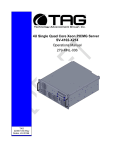



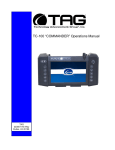
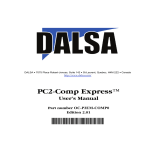
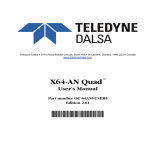



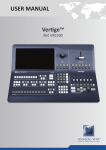


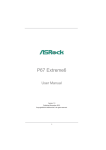
![User Manual [ ] - American Industrial Systems, Inc.](http://vs1.manualzilla.com/store/data/005674734_2-58a82461c9fcf90cc8d42d376dad67a0-150x150.png)

